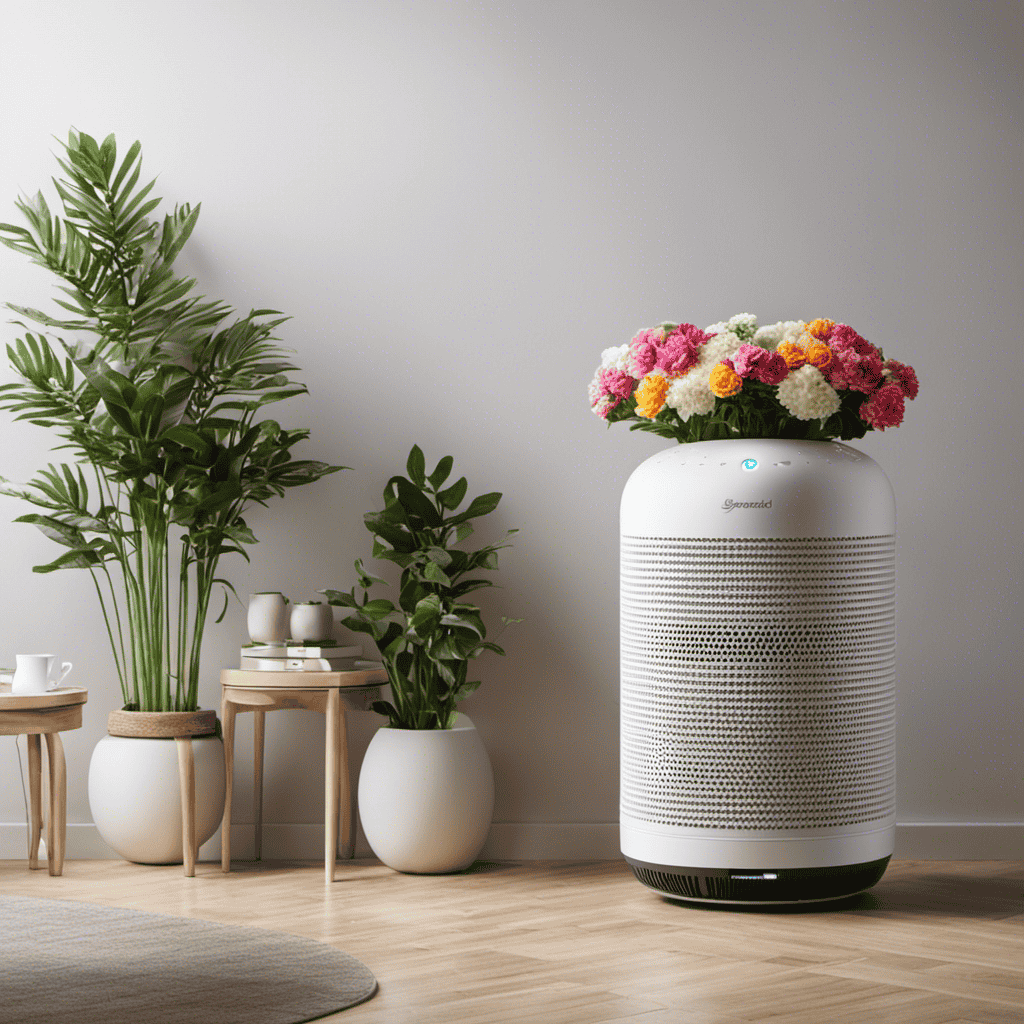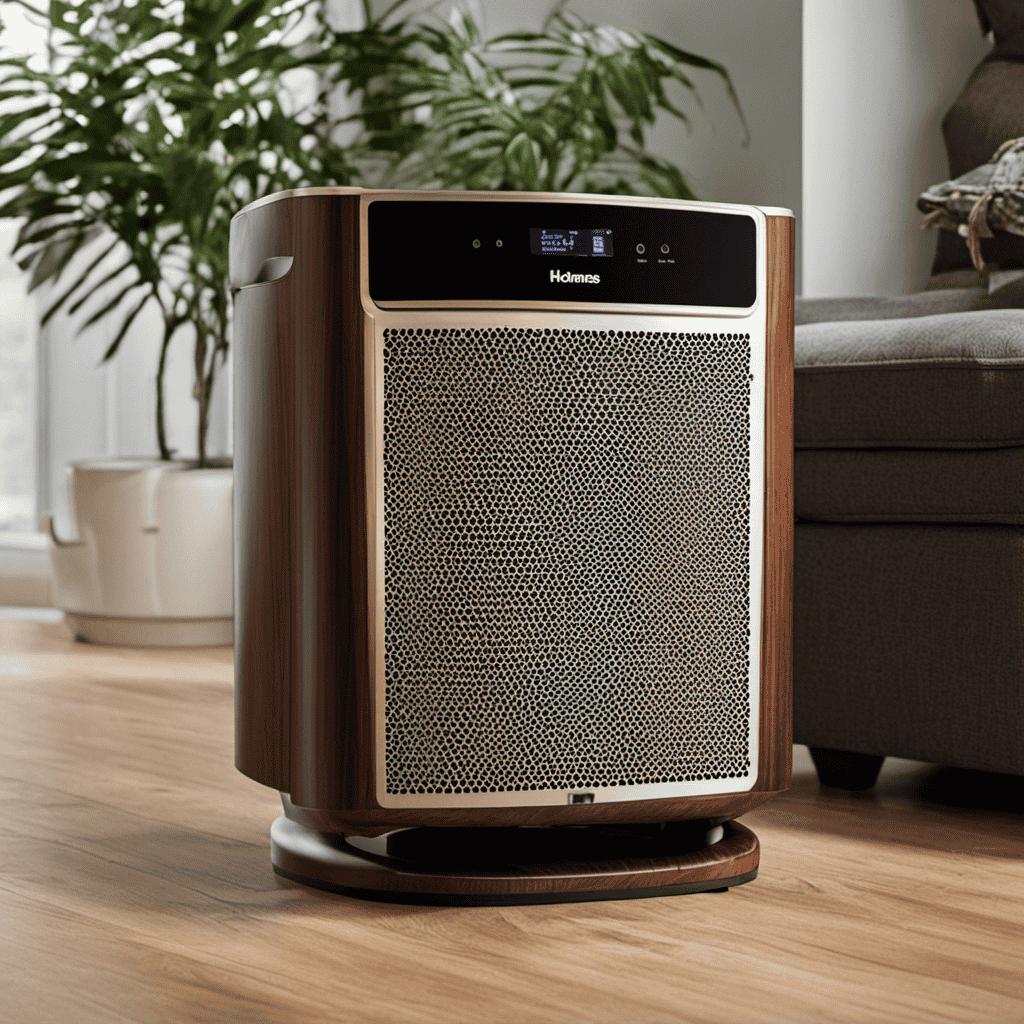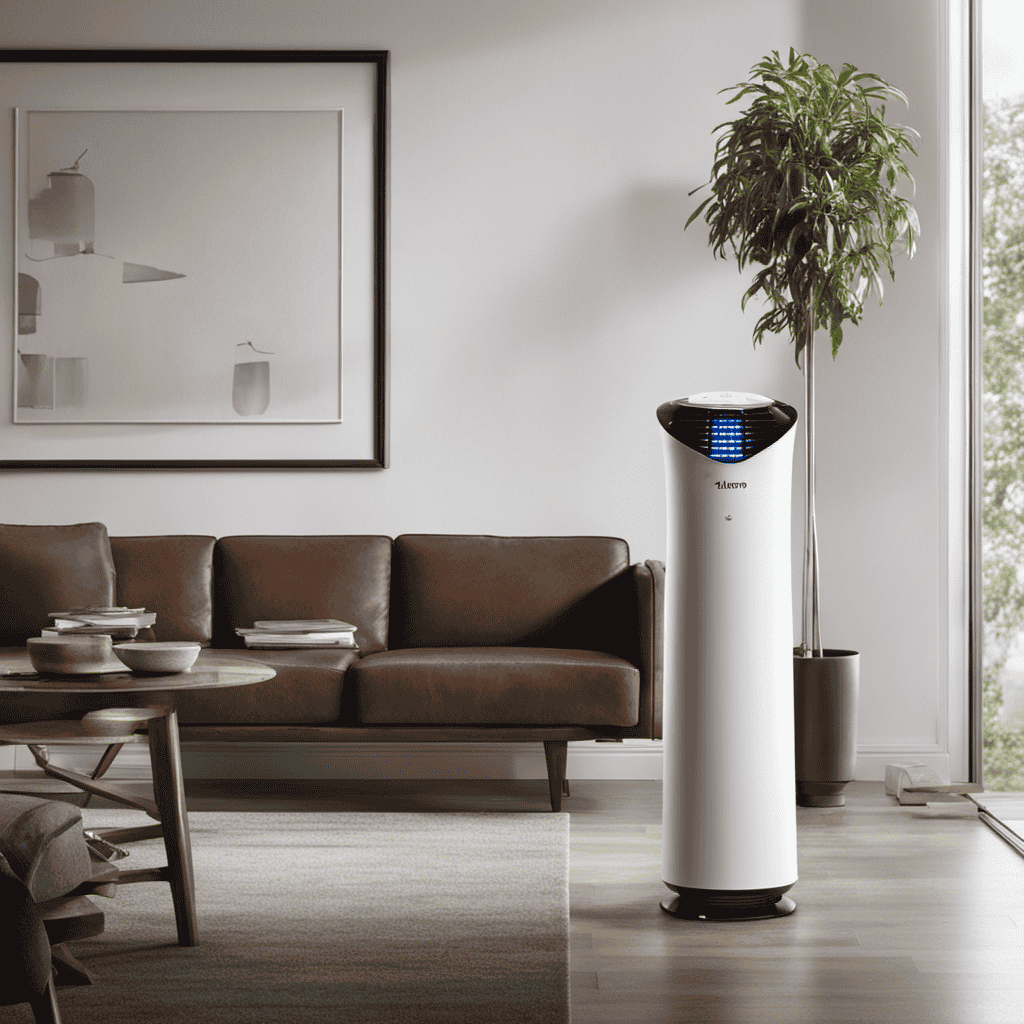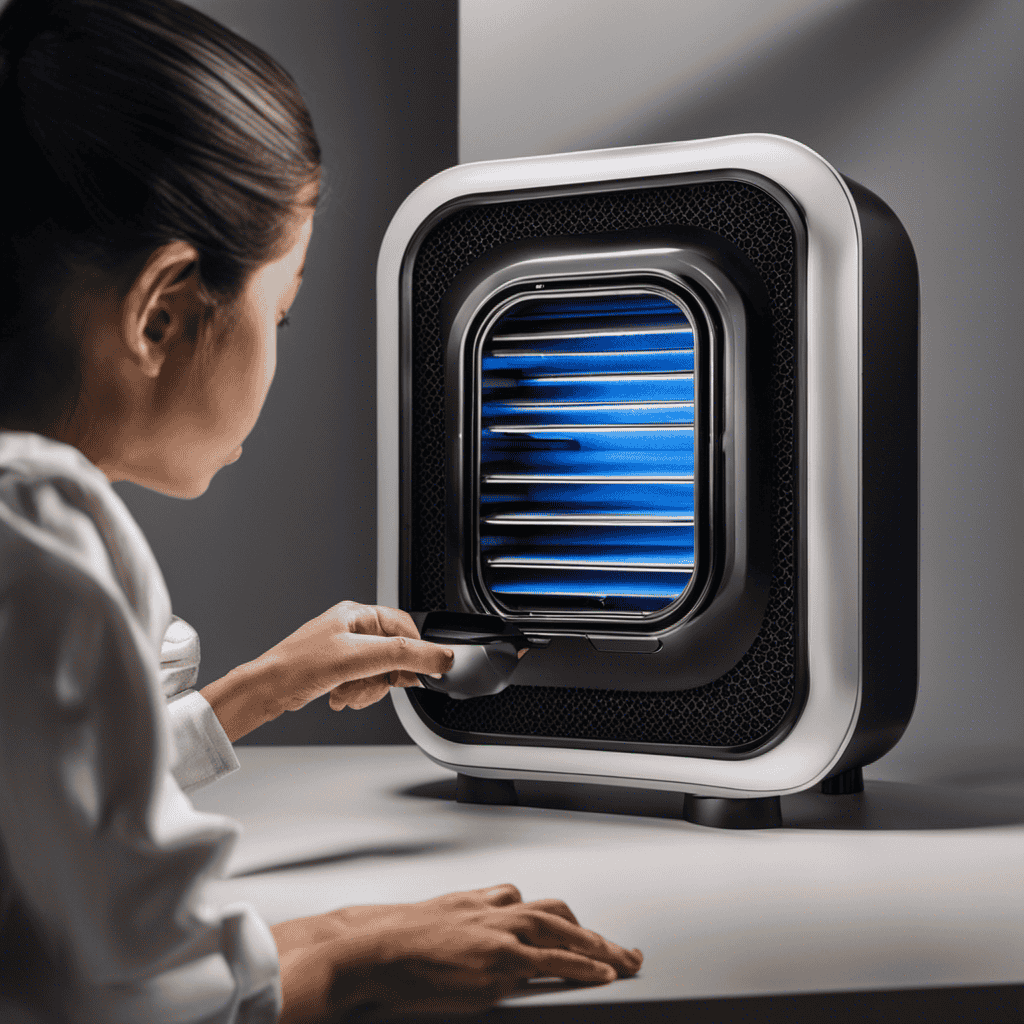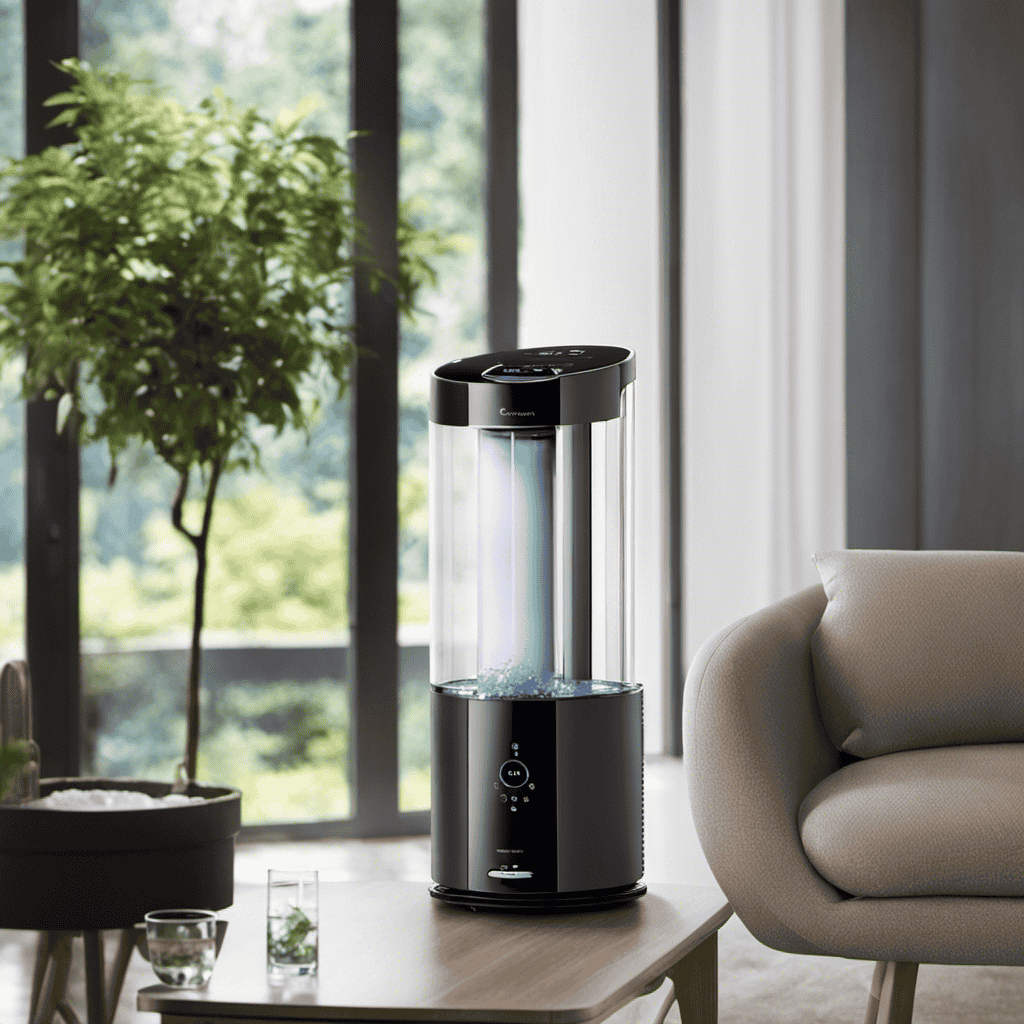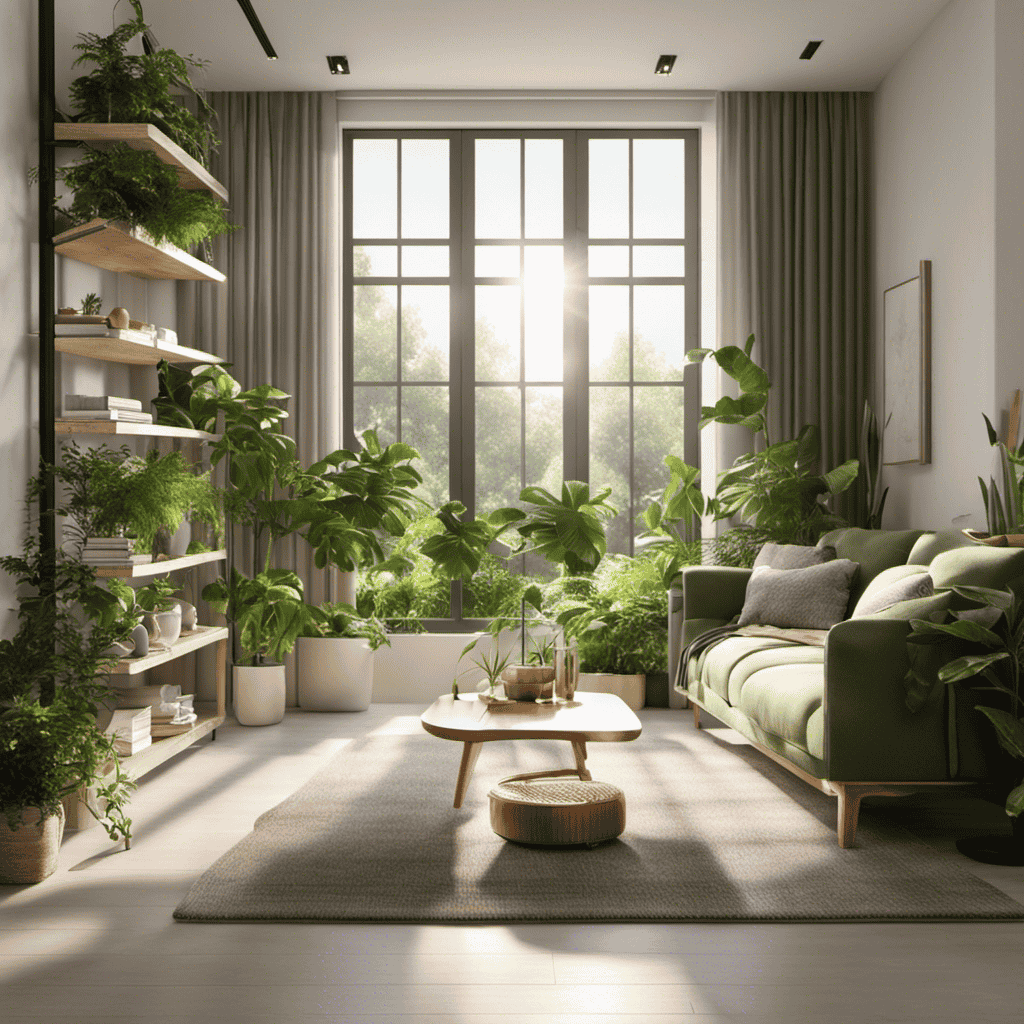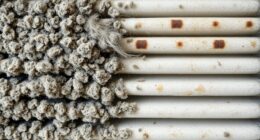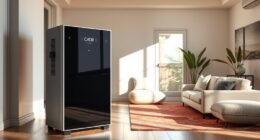As the saying goes, “Clean air, happy home.” This is the reason I’m thrilled to present to you the marvels of air purifying plants.
These beautiful plants not only add a touch of nature to your indoor spaces but also actively cleanse the air, removing harmful toxins and pollutants.
In this article, we’ll explore how air purifier flowers work, the benefits they offer, different types available, and how to incorporate them into your home decor.
So let’s dive in and discover the power of these botanical air purifiers!
Key Takeaways
- Air purifier flowers absorb harmful toxins and release oxygen into the air.
- They can remove pollutants like formaldehyde, benzene, and xylene commonly found in household items.
- Air purifier flowers improve air quality and bring benefits to overall well-being.
- Popular air purifier flowers include Peace Lily, Snake Plant, English Ivy, and Gerbera Daisy.
How Do Air Purifier Flowers Work
Air purifier flowers work by absorbing harmful toxins and releasing oxygen into the air.
Indoor air pollution is a significant problem in many homes, as it can lead to various health issues such as allergies and respiratory problems.
However, natural air purification methods like air purifier flowers can help combat this issue. These flowers have the unique ability to absorb pollutants from the air through their leaves and roots.
They can remove toxins such as formaldehyde, benzene, and xylene, commonly found in household items like furniture and cleaning products. Once absorbed, the flowers break down these harmful chemicals and release fresh oxygen back into the environment.
This natural process not only improves air quality but also brings numerous benefits to our overall well-being.
Benefits of Air Purifier Flowers
One of the main advantages of using these plants is that they can help to remove harmful pollutants from the environment. Indoor air pollution is a significant problem, as it can lead to various health issues. However, air purifier flowers offer a natural solution to this problem.
These plants have the ability to filter the air, removing toxins and improving its quality. Through a process called phytoremediation, air purifier flowers absorb pollutants like formaldehyde, benzene, and xylene and convert them into harmless substances. This natural air filtration not only helps to purify the air but also adds beauty to indoor spaces.
In the next section, we will explore different types of air purifier flowers and their specific benefits.
Types of Air Purifier Flowers
When it comes to popular air purifier flowers, there are several options to choose from. These flowers not only add beauty to your space but also have the ability to improve air quality.
The benefits of these flowers include removing toxins, reducing allergens, and increasing oxygen levels in the environment.
Popular Air Purifiers Flowers
You might be interested in checking out some of the most popular air purifier flowers available. These flowers not only add beauty to your home, but they also have health benefits and provide a fresh and aromatic atmosphere.
Here are four popular air purifier flowers that you should consider:
-
Peace Lily (Spathiphyllum): Known for its ability to remove toxins like benzene, formaldehyde, and trichloroethylene from the air.
-
Snake Plant (Sansevieria): This plant is highly efficient in filtering out formaldehyde and is great for bedrooms as it releases oxygen at night.
-
English Ivy (Hedera helix): This vine-like plant is excellent at absorbing mold spores and can help improve indoor air quality.
-
Gerbera Daisy (Gerbera jamesonii): Not only does it brighten up your space, but it also removes trichloroethylene and benzene from the air.
Benefits of These Flowers
If you’re looking to improve indoor air quality, incorporating these popular air purifier flowers into your home can provide numerous benefits. Not only do these flowers add beauty and vibrancy to your space, but they also have the ability to remove harmful toxins and pollutants from the air. The science behind air purifier flowers lies in their ability to absorb these pollutants through their leaves and roots, and convert them into harmless substances. This process, known as phytoremediation, helps to create a cleaner and healthier living environment. Additionally, these flowers release oxygen and increase humidity levels, which can further enhance air quality. Take a look at the table below to see some popular air purifier flowers and the specific benefits they offer:
| Flower | Benefits |
|---|---|
| Peace Lily | Removes harmful chemicals such as benzene, formaldehyde, trichloroethylene, and xylene |
| Snake Plant | Filters out toxins like benzene, formaldehyde, trichloroethylene, xylene, and toluene |
| Spider Plant | Removes formaldehyde, xylene, and toluene from the air |
| Aloe Vera | Absorbs formaldehyde and benzene from the air |
Best Air Purifier Flowers for Indoor Spaces
The best air purifier flowers for indoor spaces are those that can efficiently filter and cleanse the air. Indoor plants have the natural ability to improve air quality by removing harmful toxins and releasing oxygen.
Here are four air purifier flowers that are highly effective in purifying indoor air:
-
Peace Lily (Spathiphyllum): This plant is known for its ability to remove common indoor pollutants like formaldehyde, benzene, and trichloroethylene.
-
Snake Plant (Sansevieria): With its unique ability to convert carbon dioxide into oxygen during the night, the snake plant is perfect for bedrooms. It also filters out toxins like xylene and toluene.
-
Boston Fern (Nephrolepis exaltata): This fern is excellent at removing formaldehyde, xylene, and toluene from the air. It thrives in humid conditions, making it ideal for bathrooms.
-
Spider Plant (Chlorophytum comosum): Known for its easy maintenance, the spider plant effectively filters out formaldehyde, carbon monoxide, and xylene.
These air purifier flowers not only add beauty to indoor spaces but also provide a natural air filtration system. When choosing air purifier flowers, several factors need to be considered, including light requirements, maintenance needs, and personal preferences.
Factors to Consider When Choosing Air Purifier Flowers
Light requirements, maintenance needs, and personal preferences should all be taken into account when choosing indoor plants for air purification. Factors to consider include the amount of sunlight available in your space, your ability to provide the necessary care, and your aesthetic preferences. Some plants require direct sunlight, while others can thrive in low light conditions. Maintenance needs vary as well, with some plants needing frequent watering and others requiring less attention. Personal preferences play a role in selecting plants that match your interior design style and overall ambiance. By considering these factors, you can choose air purifier flowers that not only improve the air quality in your indoor space but also enhance its beauty and appeal.
| Light Requirements | Maintenance Needs |
|---|---|
| High sunlight | Frequent watering |
| Low light | Less attention |
| Moderate sunlight | Regular pruning |
Using air purifier flowers in your indoor space provides numerous benefits. Not only do these plants help remove harmful toxins from the air, but they also release oxygen and increase humidity. This can lead to improved air quality, reduced symptoms of allergies and asthma, and a more comfortable living environment. Additionally, air purifier flowers can add a touch of nature and beauty to your space, creating a calming and soothing atmosphere. With proper care and consideration of factors such as light requirements and maintenance needs, you can enjoy the benefits of using air purifier flowers while enhancing the overall aesthetics of your indoor environment.
How to Care for Air Purifier Flowers
To care for these air-purifying plants, you’ll need to consider their specific watering, pruning, and fertilizing requirements. Here are some essential caring techniques for air purifier flowers:
-
Watering: Different plants have different water needs. It’s crucial to check the soil moisture before watering. Overwatering can lead to root rot, while underwatering can cause wilting. Find the right balance for each plant.
-
Pruning: Regular pruning helps maintain the health and shape of air purifier flowers. Remove dead or yellowing leaves, and trim any overgrown branches. This promotes better airflow and prevents the spread of diseases.
-
Fertilizing: Use a balanced, slow-release fertilizer to provide essential nutrients to the plants. Follow the instructions on the fertilizer package and avoid overfertilizing, as it can damage the plants.
-
Potential Allergies: Some air purifier flowers may release pollen or have strong fragrances that can trigger allergies. Keep this in mind when choosing plants, especially if you or your family members have allergies.
Incorporating Air Purifier Flowers Into Your Home Decor
When it comes to improving indoor air quality, air purifiers can provide numerous benefits. They help remove harmful pollutants, allergens, and odors from the air, creating a healthier environment for you and your family.
Choosing the right flowers to complement your air purifier can also enhance the aesthetic appeal of your home while adding natural air-purifying properties.
With the right combination of air purifiers and flowers, you can create a stylish and healthy living space.
Benefits of Air Purifiers
One of the benefits of air purifiers is that they can help remove pollutants and allergens from the air. This is particularly important for maintaining good indoor air quality.
Here are four reasons why air purifiers are beneficial:
-
Reduction of airborne particles: Air purifiers can capture and filter out dust, pollen, pet dander, and other particles that can cause allergies or respiratory issues.
-
Elimination of harmful gases: Some air purifiers are equipped with activated carbon filters that can absorb and neutralize volatile organic compounds (VOCs) and other harmful gases.
-
Odor control: Air purifiers with activated carbon filters also help to eliminate unpleasant odors from cooking, pets, or smoke.
-
Improved overall health: By removing pollutants and allergens from the air, air purifiers can help reduce the risk of respiratory problems and improve sleep quality.
With these benefits in mind, let’s now explore the importance of choosing the right flowers as air purifiers.
Choosing the Right Flowers
After learning about the benefits of air purifiers, let’s dive into the world of choosing the right flowers for this purpose.
Contrary to common misconceptions, not all plants are effective at purifying the air. When selecting air purifier flowers, it’s essential to consider their ability to remove specific toxins from the air.
Some popular choices include peace lilies, spider plants, and snake plants. These plants have been scientifically proven to filter out harmful pollutants such as formaldehyde, benzene, and xylene.
It’s important to note that while plants can help improve indoor air quality, they are not a substitute for proper ventilation and air purification systems.
Additionally, it’s crucial to choose plants that are suitable for your home environment, taking into account factors such as lighting conditions and maintenance requirements.
Styling With Air Purifiers
To style your space with air purifiers, consider incorporating these decorative plants into your interior design. Not only will they add a touch of greenery and beauty to your home, but they will also help improve the air quality.
Here are four popular plants that are both aesthetically pleasing and effective air purifiers:
-
Snake Plant (Sansevieria trifasciata): This plant is known for its ability to convert carbon dioxide into oxygen during the night, making it perfect for bedrooms.
-
Peace Lily (Spathiphyllum): With its elegant white flowers, the Peace Lily is a popular choice for living rooms. It has been found to remove harmful pollutants such as formaldehyde and benzene from the air.
-
Boston Fern (Nephrolepis exaltata): This fern is not only visually appealing but also a great natural air purifier. It can help combat common indoor air pollutants like xylene and toluene.
-
Aloe Vera (Aloe barbadensis): Apart from its medicinal properties, Aloe Vera is also an excellent air purifier. It can help remove formaldehyde and benzene from the air.
Incorporating these plants into your interior design not only follows the latest decorating trends but also provides the added benefit of improved air quality.
Are Air Purifier Flowers Effective for Indoor Air Quality?
Yes, growing plants in air purifier can be effective for indoor air quality. Plants naturally purify air by removing toxins and releasing oxygen. Air purifier flowers, such as peace lilies and spider plants, are especially known for their air cleaning properties. This can greatly improve the air quality in your home.
Frequently Asked Questions
Can Air Purifier Flowers Completely Eliminate All Indoor Pollutants?
No, air purifier flowers cannot completely eliminate all indoor pollutants. While they have the potential to improve air quality, their effectiveness may vary depending on the type and concentration of pollutants present.
Are Air Purifier Flowers Safe for Pets and Children?
Yes, air purifier flowers are safe for pets and children. They can help remove indoor pollutants and improve air quality. Some popular air purifier flowers include peace lilies, spider plants, and snake plants.
How Long Do Air Purifier Flowers Generally Last?
Air purifier flowers generally last for several months, depending on the type. They provide numerous benefits such as improving indoor air quality, reducing toxins, and adding beauty to any space.
Can Air Purifier Flowers Help With Allergies and Respiratory Problems?
Air purifier flowers? Can they help with allergies and respiratory problems? Well, let me tell you, these little wonders have been scientifically proven to reduce indoor pollutants, improving overall air quality in your home. So yes, they can make a difference.
Do Air Purifier Flowers Require Any Special Maintenance or Care Instructions?
Air purifier flowers have numerous benefits, such as improving air quality and reducing allergens. Different types of air purifier flowers may require specific care instructions, such as proper watering and sunlight exposure.
Conclusion
After exploring the world of air purifier flowers, it is clear that these natural beauties have the power to transform indoor spaces into cleaner and healthier environments.
With their ability to filter out harmful pollutants and release oxygen, air purifier flowers are like the superheroes of the plant kingdom, fighting off invisible foes and providing us with fresh, purified air.
Just as these flowers cleanse the air, they also symbolize the potential for personal growth and renewal.
By incorporating air purifier flowers into our homes, we can create a sanctuary that not only looks beautiful but also promotes our well-being.
